Pregnancy in women is both fascinating and complicated. There are a myriad of factors that contribute to fertility and infertility alike, some of which come down to genetics and others their environment and lifestyle. A successful pregnancy begins in the uterus, where the sperm and the egg cell combine and plant itself along the uterine wall, where a zygote will form and eventually become a newborn child. Yet, not all women have the same kind of uterus. Nowadays, it is not uncommon for a doctor to diagnose a retroverted uterus in females, which is a condition that could influence how likely they are to conceive. But what exactly is a retroverted uterus and how does it play a role in fertility?
What Is a Retroverted Uterus?
A retroverted uterus is a condition in which the uterus is tilted back towards the spine instead of sitting upright or leaning slightly forward in the lower abdomen. About 1 in 5 women are born with a retroverted uterus, while some can also develop one later in life due to pregnancy or other health concerns such as endometriosis, fibroids, and pelvic inflammatory disease. Fortunately, a tilted uterus does not pose any major health risks and with it becoming a more common diagnosis, it is seen as a normal variation. In rare cases, underlying issues could worsen and even disrupt quality of life so if problems linked to this condition persist, having a discussion with a medical professional is advised.
Typically, most women with retroverted uteruses do not experience any symptoms, although there are some often associated with it, those being painful periods, problems putting in tampons, and urinary incontinence, which is a loss of control over your bladder.
Can You Still Get Pregnant With a Retroverted Uterus?
Yes! In general, having a retroverted uterus does not negatively affect a woman’s ability to become pregnant. At one time it was believed that the angle of the uterus and cervix would not allow sperm to reach the egg from the fallopian tubes, but this no longer seems to be an issue. Doctors now believe that you can still learn how to get pregnant easily with a retroverted uterus. However, having this condition can affect fertility in other ways. Some women might find intercourse to be painful, a term called dyspareunia, which can hinder conception altogether. One option around this is to try different positions, as certain angles might be more comfortable than others, along with better controlling the depth of penetration during intercourse.
Women with tilted uteruses who experience endometriosis or pelvic inflammatory diseases might also find it difficult to get pregnant. This is due to scar tissue forming in the fallopian tubes, making it harder for eggs to pass through. Even still, very few women become infertile because of this. Though these gynecological conditions are not caused by having a tilted uterus, seeking individualized treatment often helps control these health concerns from worsening and possibly impacting fertility.
Another way to alleviate some of the discomfort and increase the chance to get pregnant easily with a retroverted uterus are pregnancy massages. Focusing primarily on the lower pelvic region, massaging around the ovaries, liver, and stomach can help improve circulation and clear toxins in these areas that might now be impacted with the intestines due to a tilted uterus. This allows for better nutrient absorption, reduced stress, more oxygenated blood flow to the eggs, and decongested fallopian tubes so that fertilization is much more likely to take place.
Are There Treatment Options?
Most women are able to live a normal lifestyle with this condition without any treatment. For more persistent symptoms, a doctor may suggest exercises, prescribe a support device, or in severe circumstances, suggest a surgical procedure to correct the angle of the uterus with high success.
If you are trying to get pregnant and you find out that you have a retroverted uterus, do not panic. Overall, the impact of a retroverted uterus has minimal to no impact on pregnancy and rarely leads to any further issues without an already existing underlying health problem. While in some instances where symptoms can limit the chances to conceive, a woman’s fertility is not directly at risk and is still able to get pregnant just as easily as any other.
So what are your next steps? Once a pregnancy is confirmed by an ultrasound, expectant parents can start to plan for the baby’s arrival. Nine months may seem like a long time, but it is never too early to start financially preparing for your baby or coming up with a birth plan. Birth plans are usually discussed with your physician and can include things like place of delivery (which hospital you will choose) and whether or not you will be preserving (or donating) the stem-cell-rich cord blood from your baby’s umbilical cord. This process is known as cord blood banking, and collection takes place immediately after birth, which is why plans should be made months in advance. If you have questions about cord blood banking, please do not hesitate to contact us at CellSave.







